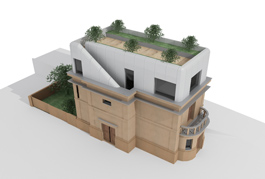
Acceptance-intervention-destruction in the DOX Centre for Contemporary Art
Biennale of Industrial Traces 2009
 |
| Ing. Bc. František Denk – T.R.A.F.O. - conversion of a former transformer station into residential space, Prague-Smíchov |
“The name AID refers not only to the English term for "help/support," which industrial heritage undoubtedly needs in our country in recent years, but is primarily an abbreviation of three strategies, thought processes that are most commonly used during conversion - acceptance, intervention, destruction,” explains the curator of the exhibition Petr Vorlík. And co-author of the exhibition Tomáš Šenberger adds: “Conversion is almost always associated with an intervention in the original building substance, but the degree of intervention depends on the conditions of the conversion, the character and form of building protection, and to a large extent also on the internal attitude (aggressiveness) of the creator.”
The exhibition of student projects for the new use of industrial monuments is also the outcome of the 5th International Biennale of Industrial Traces 2009. “The projects for this year’s biennale of Industrial Traces respond to new assignments prompted by current discussions about endangered industrial buildings,” says Benjamin Fragner, one of the main organizers of the biennale of Industrial Traces. “They perceive the critical situation of the vanishing industrial era that we are experiencing, in which a threatened cultural monument emerges from what has been an exploited industrial object. They try to deal with a legacy we have yet to fully understand, which we still only touch with hesitation. The architectural visions presented should aid in its understanding, comprehension, and new evaluation.”
The exhibition A I D as part of the 5th International Biennale of Industrial Traces 2009 was organized by the Research Centre for Industrial Heritage of the Czech Technical University in Prague in collaboration with the DOX Centre for Contemporary Art, the Faculty of Architecture and the Faculty of Social Sciences of the Czech Technical University in Prague, the AAAD Prague, and the Faculty of Architecture TU Liberec, among others. Students from these schools created original proposals for conversions of a whole range of objects that are either waiting for their further use or facing definitive destruction. The exhibition thus offers projects for, for example, the discussed object of the so-called Nusle Mill, the ice plant in Braník, the railway area in Bubny, the textile factory Florian Schmidt in Krnov, the train station in Ústí nad Orlicí, or the malt house in Český Těšín.
As a counterpoint to the exhibition mapping the possibilities of conversion and preservation of industrial heritage, another exhibition within the biennale of Industrial Traces titled What We Have Destroyed... The exhibition and the same-named publication published on the occasion of this year's biennale provide a sad balance of demolished and irretrievably lost buildings and sites of industrial heritage that have been torn down in the past ten years in the territory of the Czech Republic. The publication is being released these days. The exhibition can be viewed until October 15 in the Old Sewer Treatment Plant in Prague's Bubenč.
Part of the Industrial Traces biennale will also be a two-day international expert conference titled Industrial Heritage: In the Vacuum Between Professionals and Amateurs, which will take place on October 9 and 10, 2009, in the main center of the Biennale, in the Old Sewer Treatment Plant. Considering the limited capacity of the treatment plant space, there are only a few spots left for interested parties. All details of the broad program in all participating cities and registrations for the conference are available at www.industrialnistopy.cz.
The Industrial Traces biennale is organized by the Research Centre for Industrial Heritage of the Czech Technical University and the Collegium for Technical Monuments ČKAIT & ČSSI in collaboration with the Czech National Committee of ICOMOS, the National Heritage Institute, and the Ekotechnical Museum. The conference is organized in cooperation with the British Council. The 5th biennale of Industrial Traces is held with direct financial support from the International Visegrad Fund (IVF).
The Industrial Traces biennale also has an official page on Facebook, where current information is regularly published, and a photo gallery is also available - see here>
DOX Centre for Contemporary Art
Poupětova 1a, 170 00 Prague 7
www.doxprague.org
Opening hours
Mon: 10–18
Tue: closed
Wed to Fri: 11-19
Sat and Sun: 10–18
Under the patronage of the Minister of Culture of the Czech Republic
Organized by: Research Centre for Industrial Heritage at ČVUT and Collegium for Technical Monuments ČKAIT & ČSSI
In cooperation with: National Heritage Institute, Old Sewer Treatment Plant, British Council, Czech National Committee ICOMOS, statutory cities of Kladno, Ostrava, Liberec, Žatec, Zlín and Liberecký kraj
With the support of: International Visegrad Fund (IVF)
Partners: DOX Centre, Capital City of Prague
With participation: Czech National Bank, National Technical Museum, Academy of Performing Arts in Prague, Prague 3 City District, Prague 4 City District, Fabriky.cz
The English translation is powered by AI tool. Switch to Czech to view the original text source.
0 comments
add comment









